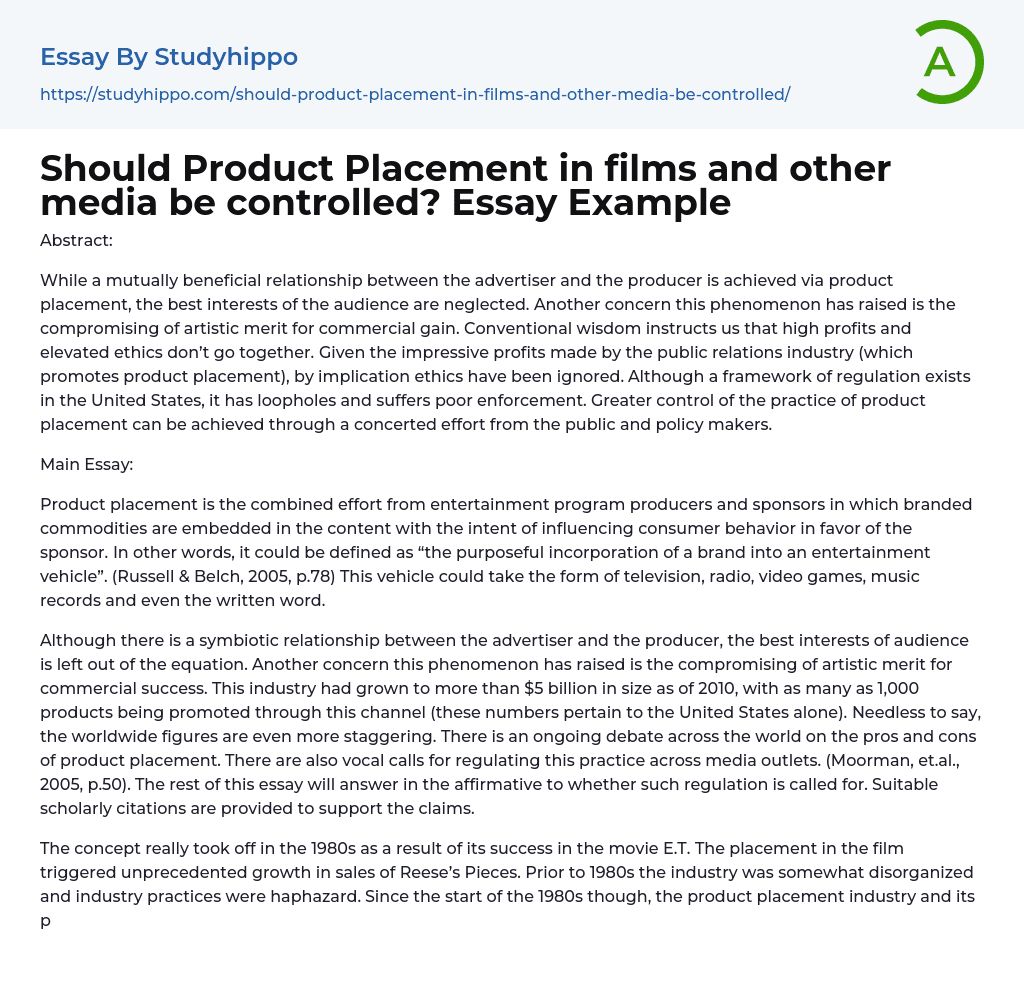

Should Product Placement in films and other media be controlled? Essay Example
Abstract:
While product placement creates a mutually beneficial relationship between advertisers and producers, it often neglects the best interests of the audience and compromises artistic merit for commercial gain. It is commonly understood that high profits and elevated ethics do not align. The public relations industry, which promotes product placement, has seen impressive profits, implying a lack of ethics. Although there is a framework of regulation in the United States, it has loopholes and suffers from poor enforcement. To achieve greater control of product placement, it is necessary for the public and policy makers to make a concerted effort.
Main Essay:
Product placement is when entertainment program producers and sponsors work together to place branded commodities within the content in order to influence consumer behavior towards the sponsor. Essentially, it is the intentional integration of a brand into an entertainment medium
...(Russell & Belch, 2005, p.78). This medium can be television, radio, video games, music records, or even written material.
Despite the symbiotic relationship between advertisers and producers, the audience's best interests are often disregarded. This issue also raises concerns about compromising artistic merit for commercial success. The industry has experienced significant growth, reaching over $5 billion in size as of 2010, with approximately 1,000 products being promoted through this channel in the United States alone. These figures are even more astonishing worldwide. The debate surrounding the advantages and disadvantages of product placement is ongoing across the globe, with many urging for the regulation of this practice within media outlets (Moorman, et.al., 2005, p.50). This essay aims to affirm the need for such regulation and provides relevant scholarly citations to support its arguments.
During the 1980s, product placement became
popular after its successful incorporation in the movie E.T., which led to a notable rise in sales of Reese's Pieces. Prior to this decade, the industry lacked organization and practices were inconsistent. However, since the early 1980s, both the product placement industry and its parent public relations industry have gained significant influence in commerce, economy, and politics. The following excerpt sheds light on the scale of the product placement industry:
According to Karrh (2007, p.140), BMW invested approximately $20 million on the marketing campaign for the launch of the Z3 roadster. This campaign included prominent exposure in the James Bond film Golden Eye, as well as in the film's trailers and TV ads. In Spielberg's Minority Report, there were interactive advertising billboards promoting placement sponsors like Mokie and Lexus, who paid around $5 million to $7 million each. Nowadays, marketers are becoming more aggressive in seeking significant roles for their brands in feature films.
The influence of a larger industry on public opinion, consumer behavior, and consumption patterns highlights the importance of examining the fairness and ethics of its practices. This can be achieved by studying the regulatory framework and factors affecting regulations. In the entertainment industry, placement agencies and content producers play key roles in decision making. To gain insight into this industry, James Karrh conducted a survey in 2007 focusing on ERMA (Entertainment Resources and Marketing Association). The survey sheds light on the current state of the industry and provides future expectations. One crucial topic is the blending of informative and persuasive content, where regulations are necessary to prevent deception when "persuasion/propaganda" disguises itself as "information." Extensive research is warranted due to the significant implications
of this phenomenon. Research on product placement has also expanded to incorporate various perspectives like cognitive response, attitudinal formation, and involvement (Moorman et al., 2005, p.50), which helps develop effective methods for regulating and managing product placement.
Content with the potential to reach a wide audience, such as movies, is an appealing medium for promoting brands. The success of the product-placement industry can be attributed to its adoption of an "integrated marketing communication" approach, as described by an industry analyst.
According to Karrh et al. (2007), the effects of product placements and other integrated marketing strategies can be understood as a "consumption constellation". In this constellation, products, brands, or activities form symbolic connections that represent or fulfill social roles for audience members. These audience members may use or avoid these products as a way to gain social status or avoid being stigmatized (p.138).
Advertising agencies were highly interested in this synergy, making it an appealing proposition. Both the industry members and their sponsors were motivated to maintain these lucrative opportunities, which is why regulations often fail to produce desired outcomes, especially in the United States. Moreover, while some bills get approved by Congress, many others never make it past the initial stages (Katz, 1993, p.76).
- Sales Promotion essays
- Advertising campaign essays
- News essays
- Collaboration essays
- Propaganda essays
- Mass Media essays
- Media Studies essays
- Youtube essays
- Journalism essays
- Radio essays
- Message essays
- Media Analysis essays
- Role of Media essays
- Social Media essays
- Social Media Marketing essays
- Social Networking essays
- Dialogue essays
- Rogerian Argument essays
- Fake News essays
- Media Bias essays
- National News essays
- The view essays
- Talk Radio essays
- Social Media Negative Effects essays
- Effects of Social Media essays
- Advertisement essays
- Advertising essays
- Anheuser-busch essays
- Audience Theory essays
- Brand essays
- Brands essays
- Competitor Analysis essays
- Consumer essays
- Detergent essays
- Marketing Management essays
- Marketing Mix essays
- Marketing Plan essays
- Marketing Research essays
- Marketing Strategy essays
- New Product Development essays
- Point Of Sale essays
- Price essays
- Procurement essays
- Product essays
- Product Differentiation essays
- Product Placement essays
- Promotion essays
- Promotion And Marketing Communications essays
- Research Design essays
- Retailing essays



